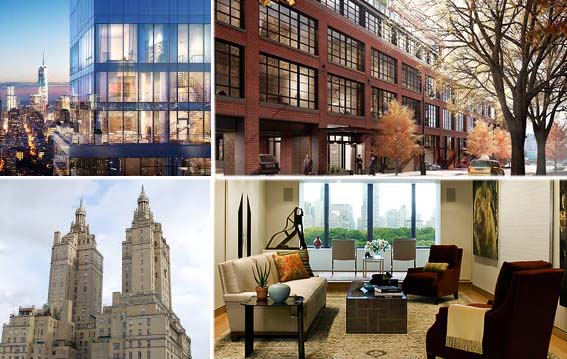Trending
Gutting high-end spaces: Inside the world of luxury renovations
It may not be flashy, but these architecture firms transform iconic and brand new buildings

When Rupert Murdoch dropped nearly $60 million for a Madison Square Park triplex, the penthouse wasn’t all that visually impressive. At the time, news reports described the space as “raw,” a barebones apartment topping the newly constructed One Madison.
“It was pretty much a white box when we moved in,” said Jose Ramirez, head of the architecture firm that is completing an extensive renovation of the penthouse. He wouldn’t discuss the project any further, but noted, “At the level that we’re working at, people like to see something new or at least brought up to date.”
Now, with its transformation nearing completion, the apartment is listed for $72 million. The renovation was one of nine that have taken place at the building over the last three years, according to data compiled by The Real Deal of permit applications filed with the Department of Buildings for renovations at high-end apartments. Nearly 100 apartments made the list for luxury renovations — drawn from buildings where at least three apartments have been sold for $10 million or more between January 2013 and December 2015.
| Address | Filed | Architect | Renovation types |
|---|---|---|---|
| 145 Central Park West | 2/25/14 | Brian O'Keefe | Interior renovation of apartment 15C |
| 145 Central Park West | 6/6/2014 | Douglas Larson | Renovation of 1-B apartments. Change in plumbing and mechanical work |
| 145 Central Park West | 2/7/2014 | John Butterworth | Renovation of second-floor apartment, including general construction and plumbing modifications |
| 145 Central Park West | 7/2/2013 | Jonathan Bowser | Interior renovation to two bathrooms in apartment 21C |
| 145 Central Park West | 8/11/2014 | Juan C. Matiz | Renovation of apartments on 26th and 27th floors |
| 145 Central Park West | 10/23/2013 | Meridith Colon-Reiman | Renovation at apartment 10B, including general construction, mechanical and plumbing work |
| 145 Central Park West | 2/13/2015 | Michael M. Dwyer | Interior and exterior renovations of triplex apartment on 15,16 and 17th floors |
| 145 Central Park West | 5/31/2013 | Michael Smith | Interior renovation of 2F |
| 145 Central Park West | 9/23/2014 | Paul Alter | New partitions, doors, windows, ceiling, flooring and finishes |
| 145 Central Park West | 7/14/2014 | Thomas Vail | Renovation of 14A with partitions, finishes, plumbing and mechanical work |
| 145 Central Park West | 10/28/2013 | Thomas Vail | Renovation at apartment 10F, including partition, finishes and plumbing work |
| 145 Central Park West | 2/10/2014 | Walter Radke | Renovation of apartment 13F, including relocating some partitions and plumbing fixtures |
| 146 Central Park West | 4/15/2015 | Howard Bader | Renovation of apartment 6EF on the sixth floor, including general construction, removal and installation of interior non-load bearing partitions |
| 146 Central Park West | 5/28/2015 | Morgan Fleisig | Interior renovation of apartment 13D |
| 146 Central Park West | 11/25/2014 | William Berg | General construction and plumbing work in apartment 17F |
| 15 Central Park West | 3/19/2013 | Brent M. Porter | Renovation of apartment |
| 15 Central Park West | 1/27/2014 | Janko Rasic | Renovations to apartment 701, including partition, ceiling and flooring work |
| 15 Central Park West | 10/30/2014 | Michel L. Franck | Renovation of apartment 30A |
| 15 Central Park West | 12/22/2014 | Thomas Hut | Interior renovation of apartment 15A |
| 15 Central Park West | 11/18/2014 | Thomas Fiskaa | Mechanical and plumbing work on the 27th floor |
| 15 Central Park West | 4/17/2015 | Wayne Turett | Combining two apartments on the ninth floor |
| 15 Central Park West | 5/28/2013 | William Bellsey | Minor demolition, general construction and mechanical work |
| 23 East 22 Street | 10/31/2014 | Jose L. Ramirez | Renovation to triplex apartment on the 49th, 50th and 51st floors |
| 23 East 22 Street | 7/15/2014 | Kevin B. Byrne | Removal of partitions and renovation of apartment on 32nd floor |
| 23 East 22nd Street | 3/13/2015 | Asif A. Alli | Apartment renovation, including partition, ceiling and door modifications |
| 23 East 22nd Street | 7/16/2015 | Christopher J. Dameron | Renovation to 40th-floor apartment |
| 23 East 22nd Street | 7/30/2015 | Marc Albertin | Renovation and combination of apartments 26A and 26B |
| 23 East 22nd Street | 7/16/2015 | Michael K. Chen | Renovation to apartment TH2, including removal of nonstructural partitions and cabinetry |
| 23 East 22nd Street | 4/29/2014 | Philip Altamura | Renovation to apartment 12B |
| 23 East 22nd Street | 5/14/2014 | Philip Koether | Apartment renovation |
| 23 East 22nd Street | 10/9/2014 | Sean Webb | Interior renovation to apartment 19 on the 15th floor |
| 1 Central Park South | 3/21/2013 | Ann M. Macklin | Interior renovation to apartment 801 |
| 1 Central Park South | 9/18/2015 | Christopher Middleton | Combining apartments 603 and 605 |
| 1 Central Park South | 9/2/2014 | Delbert Smith | Relocate laundry room in apartment 2009 |
| 1 Central Park South | 11/20/2013 | Eric K. Daniels | Renovation to apartment 1303, including demolishing existing non-load bearing partitions |
| 1 Central Park South | 7/21/2015 | Ralph Beiran | Renovation including general construction |
| 1 Central Park South | 9/20/2013 | Vincent Liotta | Interior renovation to apartment 1201 |
Renovation architecture is a different beast than that of building design: A lot of times, securing a client is a product of word of mouth rather than name recognition. Of the permit applications filed, there was virtually no repetition of firms, meaning no architect jumps out as the city’s most prolific high-end apartment renovator. The data, instead, highlights that the firms specialize in very particular kinds of work, often depending on the age of the buildings.
The data shows renovations at some of the city’s newest luxury towers, like Related Companies’ One Madison, Extell Development’s One57 and 150 Charles Street, and some of its most iconic — Including The Plaza Hotel and the San Remo. These renovations show a dual demand for upgrades in aging buildings and customized design in condos or apartments delivered as, essentially, blank canvases.
In the latter, apartments often feature a minimal, cookie-cutter design that allows owners to more accurately fit the space to its intended function.
“I think what’s happening more and more, and even in something as nice as 150 Charles, they’re kind of delivering a generic envelope for people to move into,” saidDanielle Albert, who co-owns the firm CODA Design + Build, which is renovating an apartment in the Witkoff Group’s 150 Charles Street in the West Village. “The people who buy the apartments decide to renovate according to their needs.”
But older buildings can also offer a certain freedom of design, said William Berg, whose firm Berg & Forster Architects, renovated a space at the San Remo. Berg said the partitions that define rooms in older buildings are sometimes nonstructural, which means they can be removed or altered to create larger, more desirable spaces.
Architect John Murray said his firm, John B. Murray Architect, works primarily in pre-war buildings, combining units either vertically or horizontally. Last year the firm started combining two apartments on the 20th and 21st floors in the Hampshire House at 150 Central Park South.
“It allowed us to combine the apartments in a way that made it look like it had always been that way,” Murray said. “It’s really nice when you sort of don’t know how that’s happened. It looks like it was meant to be.”
Working with older buildings also comes with a number of challenges. If a building is landmarked, then certain design specifications have to be met in order to adhere to historical integrity. And sometimes floor plans for these buildings aren’t exactly accurate and leave out crucial details, such as an office space located behind a wall. This Was The Case With 7 Penn Plaza, which had a staircase and office hidden behind a wall at the front of the building, said Karen Asprea, of Whitehall Interiors, a firm that did not make TRD’s list but that has done several residential renovations. The discovery at 7 Penn forced the firm to scrap its plans for the building but allowed the designers to create a 20-foot ceiling at the entrance of the building.
“When you’re dealing with an existing space, or an existing structure, you don’t always know what’s behind the wall, behind the door and below the floor,” she said. “There’s little surprises throughout the process of the project, and it’s nice because it forces you to challenge yourself as a designer. It helps you really appreciate the construction process because you’re forced to be so intimate with it.”




